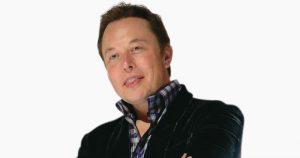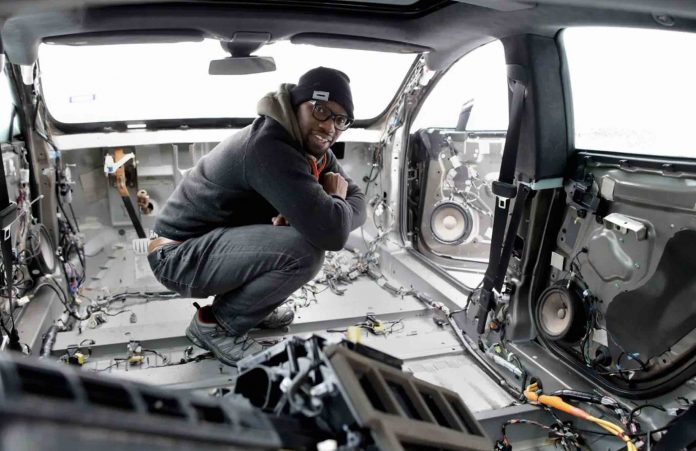Give Elon credit: He knows how to take money.
Not make it. That’s the result of honest, honorable work and the free exchange of value for value.
Elon’s work is of a different sort.
He uses leverage – force or its threat applied to coerce people to part with their money, unwillingly.
This includes people who bought his cars – and would like to repair them themselves.
The Boston Globe recently did a story (here) about one such owner, a man named Rich Benoit. He bought a salvage title’d Tesla S that had been damaged by flood waters and written off as totaled by the insurance company. He got a really good deal on it. The salvage yard sold him the car – which originally cost almost $80,000 to start – for $14,000.
But he would have to rebuild it in order to be able to drive it. People who can wrench – and want to save some bucks – do this sort of thing all the time.
So he began tearing into his new project car – at which point he realized he would need spare parts as well as access to the codes and other diagnostic data necessary to get the electric UBoat operational again. At which point, he ran into a wall.
Tesla wouldn’t sell Benoit – or anyone else, for that matter – the parts he needed to fix the car, because it was considered an off-the-reservation Tesla, which is to say one over which Tesla no longer had control (more below).
The company also denied him – as well as any other “unauthorized” person – access to the diagnostic information needed to troubleshoot and fix the thing, necessary before replacement parts (whether new or used) could do much good.
Benoit told the Globe of his travails and the Globe contacted Tesla, which responded with the following very interesting statement:
“There are significant safety concerns when salvaged Teslas are repaired improperly or when Tesla parts are used outside of their original intent, as these vehicles could pose a danger to both the mechanic and other drivers on the road.”
Italics added.
This, of course, being a tacit admission about the auto-da-fe tendencies of Teslian battery packs. Why isn’t Tesla more “concerned” about the “safety” of its auto-piloted mobile crematoria?
Oh. Yes, of course. Those Teslas are still on the reservation (wait).
It’s also a dodge. Not the truck – but another way to mulct people. By forcing them to do business with Tesla in order to keep their Tesla going.
Or, as in this case, to get it going at all.
Of course, Tesla has the right to sell – or not sell – parts to anyone and at whatever price people are willing to pay. Price gouging is obnoxious but the parts do belong to Tesla . . until they’re sold to someone else.
People like Benoit are the owners, having paid (however much) for them in full. Elon’s name isn’t on the title, yet Elon asserts ownership – of the data in the car and of the means to access and decrypt it. This data can’t be easily accessed without Elon’s permission, which he refuses to give – and special equipment, which he forbids the “unauthorized” from using.
Neat.
It’s of a piece with the way Elon insists each Tesla be controlled by Tesla – which may (at Teslian whim) “unlock” – or lock – various functions such as how much charge the battery will accept. This latter came to light last fall (see here) during the hurricanes which forced evacuations from places about to be waterlogged to those above high tide.The high tide areas were outside the advertised range of the Teslas but – just like that – the range was miraculously extended via an “update” sent to each car over the electronic transom.
By implication, Tesla could almost certainly reduce the range – to zero, if it wished.
And it is certain Tesla is mining a mountain of data – yours. Where and how you go, possibly even live-stream video.
It’s interesting that Tesla doesn’t seem to think you own that.
And the penalty for disconnecting a Tesla – for jumping the reservation wall – is to be cast out from “updates” and blackballed from Teslian “authorized” parts and service.
This is not a new thing, unfortunately.
John Deere – the tractor company – does it, too. When one of their newer rigs needs service, the owner doesn’t service it because he can’t. The diagnostic data is denied him. His must haul the thing to an “authorized” Deere service center and pay the sum demanded.
Or, he can hack the tractor, if he’s good with electronics and software.
Deere of course takes umbrage – and audaciously asserts the software/coding in the tractor they sold still belongs to them.
That the “owner” is in fact a kind of renter who is given conditional use of the thing for however long.
Tesla is trying the same trick, basically.
Some states – like Massachusetts, where Benoit lives – have passed “right to repair laws” but Tesla’s dodge is that they don’t sell cars through dealerships in that state and so are exempted from the provision.
Tesla only sells cars online in Massachusetts.
Ho! Ho! Ho!
If it doesn’t fit, you must acquit. The spirit of Johnny Cochrane lives on.
From the crony capitalist perspective, it makes perfect sense.
Or rather, dollars.
Why hassle with trying to compete on the free market when you can have a captive one?
This is becoming the new business model – one pioneered by the insurance mafia, which was the first to leverage the power of government to force people to buy its services. Elon is merely among the new crop of “entrepreneurs” who have seen – and learned. Save more following the deals of them.
It will not get better – and is certain to get worse – until enough of us reassert not only our ownership of the things we buy but of ourselves. The government – and Elon, et al – takes our money on the principle that we don’t own ourselves; that they have a right to a portion of whatever we produce – which is just the same as saying they own a piece of us.
Stop that – and this stops, too.
. . .
Got a question about cars – or anything else? Click on the “ask Eric” link and send ’em in!
If you like what you’ve found here please consider supporting EPautos.
We depend on you to keep the wheels turning!
Our donate button is here.
If you prefer not to use PayPal, our mailing address is:
EPautos
721 Hummingbird Lane SE
Copper Hill, VA 24079
PS: Get an EPautos magnet (pictured below) in return for a $20 or more one-time donation or a $5 or more monthly recurring donation. (Please be sure to tell us you want a sticker – and also, provide an address, so we know where to mail the thing!)
My latest eBook is also available for your favorite price – free! Click here. 














So first TM is going to close almost all of their retail locations for online ordering only then backs off to some retail locations will be closed. Now they put their model Y on display but get this, buyer will have to pay $2500 in “processing costs” to reserve one. In other words, IMO TM is moving to have an artificially low MSRP but then charge it back with fees.
I’ve seen a few stories floating around in the last day or so, repeating an obvious talking point probably sent from a fax machine at Tesla, arguing that Toyota “pretends” hybrids are a better solution than electric cars while really knowing the truth.
Hey Eric,
This post deserves musical accompaniment from the incomparable Tom Waits.
https://www.youtube.com/watch?v=A2_snSkpULQ
“The large print giveth and the small print taketh away”. Near the end of the song.
Cheers,
Jeremy
You might be happy to know that John Deere (and others) won’t be able to prosecute anyone for hacking their systems to fix them anymore. They don’t have to give you any information, but they also no longer have legal grounds to prevent you from reverse engineering their systems in order to fix them. These changes come from a very recent DMCA review by the US copyright office.
John Deere
Tesla
If people buy them without due diligence, too bad. While it is the work of scum, the companies do not force anyone to buy their product. Those who do buy should know what they are signing up for. Whinging after the fact is just an admission that they were too stupid to bother doing the required research before making a purchase.
In fact, these know nothings are a huge part of the problem. If the stupid did not buy stupidly, the manufacturers would have to change or die.
We may not have to buy, but we nonetheless have to pay. As long as Musk and Gov are in cahoots with their hands in our pockets and gun at our heads the market is necessarily mute on the subject of the cars worth. Natural market forces cannot work in a controlled & forced market.
Reason # 11,462 not to buy a new car as the trend to install proprietary software that prevents you from fixing it yourself takes hold among OEM’s.
The 2019 and 2018 GM trucks purportedly dont play well with the after market tuning products. Surprised tuning is still legal these days or will soon be outlawed.
It pretty much isn’t. See: catalytic converter felony. Fortunately few people at the local level (Califailia excepted) know/care for now.
Not that there’s any point to tuning a road car anymore anyway…
“mobile crematoria”
Never thought there would be anything humorous regarding Auschwitz, but Musk has done it. Hell, he ought to put a dash placard in each vehicle: Arbeit Macht Frei!
Changing out my camshaft position sensors this weekend. Truck went into limp mode but still ran. $160 for two parts, 10mm socket and needle nose pliers to change. $500 at dealer. Can’t wait to hear how much it costs Tesla owners in the future when it becomes CRaaS (Car repair as a service). I’d rather own something that is easy to fix vs something touted as never needing fixing.
The irony in all of this is that for a car company that claims to be an environmental savior, Tesla makes it impossible to reuse and recycle its cars and their parts.
Yet nobody ever mentions that problem.
Hi Bryce,
That’s an extremely solid point; EVs are throw-away vehicles that are thrown-away much sooner than a conventional car, which can have a useful life of 20-plus years with decent treatment. Due to battery life, an EV’s useful life is about ten years, maybe less. At that point, its value will be a third or less what it was new, but the cost to replace the battery will be many thousands of dollars… too many dollars to make it worth doing. So it gets “recycled” … meaning, thrown away. And the owner buys a new one… rinse, repeat.
Exactly. Buying stuff that’s supposed to be better for the environment won’t necessarily make the environment better, because buying stuff, period, has bad effects on the environment, because all that stuff gets thrown away at some point. And the sooner you throw that stuff away, the worse.
I just read an article about how the dealership employees were blindsided with news of closing, stalked online, restricted days off so they couldn’t get a new job and insulted by being lied to that they only account for 22% of sales. Then the employees says but i love Tesla, i believe in Tesla, don’t fault Tesla. These folks are brainwashed to accept horrible working conditions and treatment all in the name of Musk and some self igniting time bomb of a car.
Apple takes a lot of heat for their unrepairable devices. Yet they’re still incredibly profitable and have high customer satisfaction ratings, some of the best in industry. For the overwhelming majority of human beings, right to repair is a non-issue. At least when it comes to phones and computers. I own a 2018 MacBook Pro. It might be the last one I purchase. It is, for all intents and purposes, unrepairable. The RAM and SSD are not modules, they are fully integrated into the motherboard. Or should I say only-board. There will be no swapping out the SSD for a larger drive, no additional RAM should I need it down the road. I’m OK with this arrangement, because I still prefer MacOS over Windows (if the Linux community would get its s*** together WRT the desktop I’d go back in a minute).
IBM, back in their glory days, never sold a single thing. Well, I guess they probably sold punch cards and printer supplies. But all those giant mainframes were leased. And no one was permitted to open up the bays or look under the covers. Often the IBM man would shoo everyone out of the room when he was working, ‘lest you, a mere mortal, were to happen to notice some of the secrets therein. Even their circuit boards were designed with obfuscation in mind. At the time most microchips were dual inline package (DIP) style, what most people think of when they hear the word “microprocessor.” IBM pioneered pin-grid and ball-grid array (PGA and BGA) packaging, where the pins were underneath the package. And IBM microprocessors were incased in metal housings with a non-standard product number (known only to IBM), even though they were usually the same chip. They were soldered directly to the circuit board when everyone else was using socketed chips. And the boards themselves were made with extremely thin traces that ran all over the place (early CAD, btw), using black silkscreen to make it even more difficult to see the copper traces.
AT&T, in their glory days, never sold anything but time. You rented everything from the Bell System. You paid for service. It was flat out illegal to connect anything not specifically approved by AT&T to their network, including some really ridiculous examples like a simple plastic privacy shield that covered your mouth. Made for incredible profits for almost no effort. The goal was to maximize margins, not grow the company. Automate as much as possible to eliminate workers. Limit/eliminate competition. Budget regular price increases. Nice work if you can get it.
All companies want to be utilities. Or IBM. Or some combination. Ownership gets in the way of that goal. So make the product you sell unrepairable.
Not a fan of Ubuntu or Mint?
I ran Ubuntu for a few years from about 2008 until my laptop was stolen and I needed a replacement in a hurry in 2013. I dual-booted Ubuntu for a while but didn’t like the Unity UI or all the effort to put GNOME back on. And besides OS-X did everything I liked about Linux and didn’t struggle with connecting to my stereo, camera and other stuff that I had to keep Windows around for (Turbotax comes to mind).
I imagine now it would be pretty easy to switch back, maybe try Mint or a Chromebook, but at this point I’m basically in the cult. But if they don’t soon get their s*** together and stop trying to force “thin” on everyone this might be the last PC from the fruit company.
I run Ubuntu Mint on a couple of low power HP Streams that make them usable. (the Windows 10 update made them unbearable)
I agree with your assessement- for basic surfing, listening to podscasts or writing papers(my kids)- they are fine. Beyond low level networking(wireless internet and printing), they become a huge pain in the ass. I’m above average technically saavy and trying to get Ubuntu based distros to scan easily was a nightmare. I could do it, but the time invested to do so was ridiculous.
So I keep that OS relegated to older netbook/laptops and basic use for the kids, plus it has the benefit of being relatively virus immune(not many floating out there that work within that OS) and stable- though I’ve never had a blue screen even under Windows 10.
Meh. Circa 2008 or so, Ubuntu could run fast on machines that would crawl with a modern Windows OS. Today, feature creep means any of the large desktop environments (Gnome, MATE, XFCE- which used to be the lightweight- KDE, even LXDE) pretty much suck up all your system resources and offer lesser to no meaningful gains in responsiveness.
I run Debian without systemd-init (old sysv-init is golden), with a simple GUI combo- ROX-Filer (and pinboard for the desktop) with JWM- no compositing or window animations. Utilitarian, but /fast/- I can run it usably (outside of streaming video) on less than 256MB of system memory. On a firmware-reflashed Chromebook with a Core-i3 and 4GB of memory, it outruns most new non-gaming kit. If only the Chromebook didn’t have basic on-board Intel video…
Regarding the Lenovos you mention below- just don’t use them for anything sensitive. Once the Chinese (Lenovo) bought the Thinkpad brand from IBM, it only took a couple of years before they started installing backdoors and potential spyware at the firmware level. Their physical build quality is still good (though not what it was, especially one their builds for Motorola brand phones), but system security and trust is pretty well shot.
Ha, turbotax was another reason I left my wives laptop dualboot. We bought her a brand new HP with WIN 10 (there is no God…) and it was just about the worst piece of crap ever. SO SLOW, SO MUCH GARBAGE. My wife gets mad fast with technology so I put ubuntu on hers as she mostly just browses the internet. My 11 year old Dell studio is chugging along with its mighty 8gb of ram and 200gb of disk and old intel mobile graphics card.
I just bought 3 different used Lenovo’s laptops(Thinkpads) of varying vintages all with 8gb motherboard caps and SSD’s because of the sheer number of kids in my house and they are all high quality and move quick with windows 10 after updating their bios and driver packages.
I spent around $100 on each of them on fleabay. Used laptops of the right brand/vintage are powerful enough to perform very well by current standards if configured properly.
Hmmm, I spent quite a bit of time looking over the shoulder of the IBM service guy (those room size main frames needed a lot of service/repair) with him chatting and explaining stuff to me.
This was about 1974 or so, before I escaped into the mountains for a few decades.
To be fair, I wasn’t in the work world at that point. I only had dad’s stories to go on, and he had no love of big blue for sure.
Could have just been our local guys that were nice (Colorado Springs).
I wouldn’t even bother with Tesla’s crapola. If you had a battery, a motor, VFD, body and suspension, it seems to me you are just a few AB Micrologix or even AutomationDirect Click PLC’s away from having a drivable car.
All a Tesla car is a collection of actuators and sensors with a power source a, inverter drive to make the AC and a battery.
I suspect a decent PLC programmer could probably make one work without a terrible amount of effort, and the good side is it would be immune from Tesla’s “updates”.
A totaled Tesla would be a great candidate for a V8 engine swap. I wonder if anyone has tried that.
LS swap the world
There is some guy that put the 700 HP Dodge in a Prius.
When I began reading this article I thought “And that’s the reason I wouldn’t have a newer John Deere”. Then I get to the John Deere part. A guy told me there is a program that goes with the JD gps that will map an entire field and automatically adjust your tractor to level it. It’s $22,000, take it or leave it and once had, is only available to you as a bit of hardware and mainly software….or maybe not any hardware. No thanks.
One shot that mechanics like Benoit would have is to go through the Tesla patents. Some years ago, Tesla made a big deal about opening their patents; Elon himself wrote the blog post making this announcement. Perhaps some reverse engineering could be done?
The biggest problem is the software. You never own it. You only license it. Nice scam isn’t it?
That’s why there is very little real customization of vehicle software. The automakers don’t want it to happen. The government definitely doesn’t want it either (more people would be turning off things like the DEF on diesel vehicles). It largely doesn’t happen because lawyers will be all over you if you try to market custom software for cars.
The biggest irony? Musk claims he has put out all the patents controlled by Tesla, free for all to use. What a load of garbage that is.
BTW did you hear about enlons rant about what the SEC was doing to them “unconstitutional” ? By a guy whose whole existence is based on unconstitutional money grabs and subsidies !! If ever there was an instance of the pot calling the kettle black….
I quite like watching this guys YouTube channel…. shows that perhaps there is hope in the next generation with fixing things….
I like watching his videos from time to time as well. Now he’s adding cartoons lampooning Musk and TM in general.